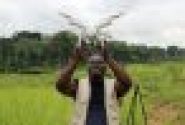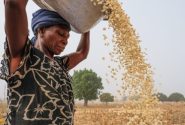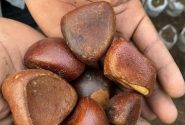
Children from 22 villages each drew two pictures to show their current impressions of the forest and its wildlife and how they envisage it in the future. CIFOR/Gugi Ginanjar
Children living in the Indonesian forests of Borneo island portray a bleak image of the future, according to preliminary findings on environmental perceptions revealed by a researcher at the Center for International Forestry Research (CIFOR).
Drawings by almost 250 children between the ages of nine and 15 living in the provinces of East and West Kalimantan consistently depict a future environment characterized by mostly non-forest landscapes with animals either non-existent or corralled into small areas.
“The children had a clarity of vision of land cover and land-use change we would normally expect to be higher among adults, not children,” said scientist Anne-Sophie Pellier.
“Interestingly, the further removed their present landscape is from the original natural forest landscape, the more environmental change they expect in the future.”
The study seeks to understand whether children living in different types of landscapes show different perceptions of their future environment.
Children from 22 villages each drew two pictures to show their current impressions of the forest and its wildlife and how they envisage it in the future.
“We were surprised to discover that children at such a young age have strong understanding of their environment and the interactions between several environmental factors,” Pellier said, adding that they were able to cite specific examples of issues that are currently occurring.
The children often cited human intervention as potential causes of environmental degradation, revealing also that they believe natural disasters and temperatures will rise as a result of the destruction of the natural forest, she said.
“Humans already have cars, and the people who logged forest today will become rich later,” observed one child.
“Everything is already gone and will be replaced by buildings: the rivers, the mountains, and everything as the forest will not be anymore. Animals will be rarely seen, only butterflies. There will be no birds or monkeys because the forest will be gone.”
Borneo, divided between Indonesia, Malaysia and to a lesser extent Brunei, is home to some of the world’s largest tracts of tropical forests. But trees are being clear cut and burned at an alarming rate to make way for large-scale timber and palm oil plantations and sprawling coal, gold and tin mines.
Clear-cutting has had a severe impact on wildlife, including such species as the orangutan, hornbill bird and pangolin anteater, which are also under threat due to illegal hunting and trade.
The information gathered is part of the Borneo Futures research project, established in 2011, which aims to provide a better understanding of how forests and lands could be more optimally managed on the island. Capturing people’s perspectives about forest use and values is one of the key research components.
The researchers use the findings to assess the underlying socio-economic and environmental factors affecting these perceptions.
The team working on the Borneo Futures project, led by scientist Erik Meijaard, hope it will better integrate the voices of local people in government policy-making, said Pellier, who is leading the research on children’s views.
“Children are the generation responsible for the future condition of the environment and their welfare, it’s important to understand how they perceive it,” she said.
“Understanding what drives environmental views among children and how they consider trade-offs between economic development and social and environmental change could help inform optimal policies on land use,” Meijaard added.
For the Borneo project, researchers interviewed adult villagers, but for children the process was too restrictive.
“Drawings prove a good methodological means of capturing the perceptions of children especially when they are too shy to write, unable to write or can’t put their thoughts into words,” Pellier said, pointing out that children find drawing enjoyable and that it allows them to express themselves freely.
This research is also to influence education and awareness programmes to reinforce positive behaviour toward the environment, she said.
This work is part of the CGIAR Program on Forests, Trees and Agroforestry , supported by the United States Agency for International Development (USAID) Forests and Environment research program and the Arcus Foundation.
We want you to share Forests News content, which is licensed under Creative Commons Attribution-NonCommercial-ShareAlike 4.0 International (CC BY-NC-SA 4.0). This means you are free to redistribute our material for non-commercial purposes. All we ask is that you give Forests News appropriate credit and link to the original Forests News content, indicate if changes were made, and distribute your contributions under the same Creative Commons license. You must notify Forests News if you repost, reprint or reuse our materials by contacting forestsnews@cifor-icraf.org.
Further reading
Seeing the fruit for the trees in Borneo
Life after logging: Reconciling wildlife conservation and production forestry in Indonesian Borneo
Drought, fire and tree survival in a Borneo rainforest, East Kalimantan, Indonesia
Pellier, A-S., et al. (in prep). “Through the Eyes of Children: perceptions of environmental change in Borneo”
Meijaard, E. et al. (in review). "People’s perceptions on the importance of forests on Borneo." PLoS ONE












